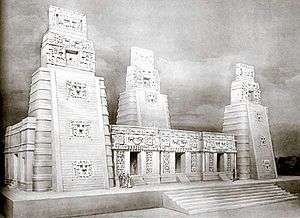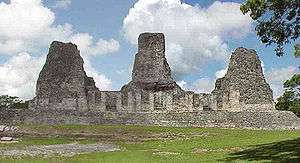Tatiana Proskouriakoff
| Tatiana Proskouriakoff | |
|---|---|
 | |
| Native name | Татья́на Авени́ровна Проскуряко́ва (Tat’yana Avenirovna Proskuriakova) |
| Born |
January 23, 1909 Tomsk, Tomsk Governorate, Russian Empire |
| Died |
August 30, 1985 (aged 76) Cambridge, Massachusetts, United States |
| Residence | Lansdowne, Pennsylvania, United States |
| Citizenship | United States |
| Nationality | Russian |
| Fields | Mayanist archaeology and linguistics |
| Institutions |
Peabody Museum of Archaeology and Ethnology Carnegie Institution of Washington University of Pennsylvania Museum |
| Alma mater | Pennsylvania State University |
| Known for | Seminal contributions to Mayanist archaeology |
Tat’yana Avenirovna Proskuriakova (Russian: Татья́на Авени́ровна Проскуряко́ва) (January 23 [O.S. January 10] 1909 – August 30, 1985) was a Russian-American Mayanist scholar and archaeologist who contributed significantly to the decipherment of Maya hieroglyphs, the writing system of the pre-Columbian Maya civilization of Mesoamerica.
Early life
She was born in Tomsk, in the Tomsk Governorate of the Russian Empire to a chemist and his physician wife. The family travelled to the United States in 1915, her father being asked by Tsar Nicholas II to oversee the production of munitions for World War I. The Russian Revolution forced the family to remain permanently. She was to visit Russia only once after that, to meet the Mayanist Yuri Knorozov.
She was devoted to a career in interpreting art, architecture, and hieroglyphic. While growing up, Tatiana could read fluently at the age of 3. She had a talent for drawing and received lessons in art and watercolor.[1]
The family lived for a while in Ohio, and moved to the Philadelphia area before settling down in Lansdowne, Pennsylvania. Tatiana did very well at school, was the editor of the school yearbook, and graduated valedictorian of her class.
She spent a year studying at the University of Pennsylvania before graduating from the Pennsylvania State University in 1930. Initially educated as an architect, she later went on to work for Linton Satterthwaite and for the University of Pennsylvania Museum at the Maya site of Piedras Negras in 1936–37. The Piedras Negras site lies between Mexico and Guatemala. Traveling there was the start of her life's work, as she found a passion for studying the ancient Maya. She made a reconstruction drawing of the Piedras Negras acropolis on her return to Philadelphia.
Reconstructive archaeology


While enrolled in graduate studies at the University of Pennsylvania, Proskouriakoff prepared archeological illustrations as a volunteer at the University Museum. Through her work with the Museum’s Assistant Curator of the American Section, Linton Satterthwaite, Proskouriakoff received an invitation in 1936 to join the Museum’s excavation work at the Mayan site of Piedras Negras.[2]
Although Proskouriakoff never received a degree in the field of Maya studies, her dedication and ability for it led to her receiving positions at the Carnegie Institution in Washington D.C., then later at Harvard University. Her position at Carnegie was procured when Sylvanus Morley saw the panoramic reconstruction on a visit to the Museum; he was impressed, and prevailed upon her to make more for the Carnegie Institution of Washington. Unable to get the institution to hire her, he raised funds to enable Proskouriakoff to travel to Copán and Yucatán, which she did in 1939. Returning after she completed the drawings, she was given the post of a research associate at the Institution in the early 1940s.
She soon became involved in Maya hieroglyphs and made significant contributions to the understanding of Mayan written language. For example, her 1942 scholarly analysis of the hieroglyphics at the Takalik Abaj ruins in Guatemala establish that the site was in part Maya, settling a debate at that time.[3] Her greatest contribution was considered the breakthrough for Maya hieroglyphic decipherment in the late 1950s and early 1960s. Utilizing the theories of Yuri Knorozov, she discovered that the writing on the monumental stela and other buildings was actually historical, dealing with the birth, accession, and death dates for the Maya rulers. Analyzing the pattern of dates and hieroglyphs, she was able to demonstrate a sequence of seven rulers who ruled over a span of two hundred years. Knowing the context of the inscriptions, Maya epigraphers were then able to decipher the hieroglyphs.
She became honorary curator, Maya art, of the Peabody Museum in 1958. Tatiana Proskouriakoff died in Cambridge, Massachusetts, on August 30, 1985. She was 76 years old.[4] She was buried at Piedas Nigras in the Structure J-23, on Easter Sunday,[5] in April 1998;[6] a plaque in her honor shows her tomb.
Awards and recognition
- Alfred V. Kidder Medal for eminence in American archaeology, 1962
- Woman of the Year by Penn State, 1971
- Order of the Quetzal, Guatemala's highest honor, 1984
- Honorary Doctorate of Laws from Tulane University, 1977
- Elected to membership in the American Philosophical Society, 1983
Published works
Proskouriakoff's publications include:
- An Inscription on a Jade Probably Carved at Piedras Negras Notes on Middle American Archaeology and Ethnology II, 1944
- An Album of Maya Architecture, 1946
- Middle American Art, 1950
- A Study of Classic Maya Sculpture Carnegie Institute of Washington Publication No. 593, 1950
- Varieties of Classic Central Veracruz Sculpture American Anthropology and History LVIII, 1954
- Historical Implications of a Pattern of Dates at Piedras Negras, Guatemala American Antiquity XXV, 1960
- Portraits of Women in Maya Art, 1961
- Lords of the Maya Realm Expedition Magazine IV(1) 1961
- Mayapán, Yucatán, Mexico (with H E D Pollock, A L Smith and R L Roys) Carnegie Institute of Washington Publication No. 619, 1962
- Historical Data in the Inscriptions of Yaxchilan, Part 1 Estudios de Cultura Maya III, 1963
- Historical Data in the Inscriptions of Yaxchilan, Part 2 Estudios de Cultura Maya IV, 1964
- Olmec and Maya Art: Problems of Their Stylistic Relation Dumbarton Oaks Conference on the Olmec, 1968
- Classic Art of Central Veracruz Handbook of Middle American Indians Vol XI, 1971
- Jades from the Cenote of Sacrifice
- Maya History, 1993 (ISBN 978-0-292-76600-6)
- Graphic designs on Mesoamerican pottery
- Maya calendar round dates such as 9 Ahau 17 Mol
- The Maya : An Introduction (with L S Spotnitz, J A Sabloff and G R Willey)
Notes
- ↑ Char Solomon. "Tatiana Proskouriakoff (1909-1985) and her Contributions to Mesoamerican Archaeology". June 2007. Retrieved 2011-10-24.
- ↑ Pezzati, A. (2001). The Hand of Fate in Tatiana Proskouriakoff's Career. Expedition, 43(3), 3. Retrieved from EBSCOhost.
- ↑ McNally, Shelagh (2006). Guatemala: Pocket Adventure Guide. Hunter Publishing, Inc. p. 264. ISBN 1-58843-528-8.
- ↑ Walter, Sullivan (1985-09-11). "Tatiana Proskouriakoff Dies. Key Figure in Mayan Studies.". New York Times. p. 27. Retrieved 2008-09-14.
Tatiana Proskouriakoff, whose deciphering of Mayan glyphs helped lay the foundations of modern Mayan historical studies, died Aug. 30 in Cambridge, Mass., the Peabody Museum of Harvard University said yesterday. She was 76 years old and was long associated with the museum. She was also widely known for her ...
- ↑ Stephen D. Houston, Investigations at Piedras Negras, Guatemala: 1998 Field Season, p.6.
- ↑ Solomon 2002, p.168-169.
References
- Coe, Michael D. (1987). The Maya. Ancient peoples and places series (4th revised ed.). London and New York: Thames & Hudson. ISBN 0-500-27455-X. OCLC 15895415.
- Coe, Michael D. (1992). Breaking the Maya Code. London: Thames & Hudson. ISBN 0-500-05061-9. OCLC 26605966.
- Coe, Michael D.; Mark van Stone (2005). Reading the Maya Glyphs (2nd ed.). London: Thames & Hudson. ISBN 978-0-500-28553-4. OCLC 60532227.
- Marcus, Joyce (1989). "Tatiana Proskouriakoff". In Ute Gacs; Aisha Khan; Jerrie McIntyre; Ruth Weinberg. Women Anthropologists: Selected Biographies (Reprint of Westport, CT: Greenwood Press original [©1988] Illini Books ed.). Urbana: University of Illinois Press. pp. 297–302. ISBN 0-252-06084-9. OCLC 19670310.
- Sharer, Robert J.; Loa P. Traxler (2006). The Ancient Maya (6th, fully revised ed.). Stanford, CA: Stanford University Press. ISBN 0-8047-4816-0. OCLC 28067148.
- Solomon, Char (2002). Tatiana Proskouriakoff: Interpreting the Ancient Maya. Norman: University of Oklahoma Press. ISBN 0-8061-3445-3. OCLC 48965183.
- Stuart, David (December 1987). "Ten Phonetic Syllables" (PDF online republication: October 2005). Research Reports on Ancient Maya Writing, 14. Washington, D.C.: Center for Maya Research.
- Villela, Khristaan D. (2000). "Morley Hires Tatiana Proskouriakoff" (PDF online reproduction). The PARI Journal. San Francisco, CA: Pre-Columbian Art Research Institute. I (2). ISSN 1531-5398. OCLC 44780248. Retrieved 2006-07-28.
External links
- Maya Writing. David Stuart and Stephen D. Houston (1989); Scientific American
- Morley Hires Tatiana Proskouriakoff (PDF). Villela, Khristaan D. (2000); Precolumbian Art Research Institute Journal
- Guatemala, Cradle of the Maya Civilization